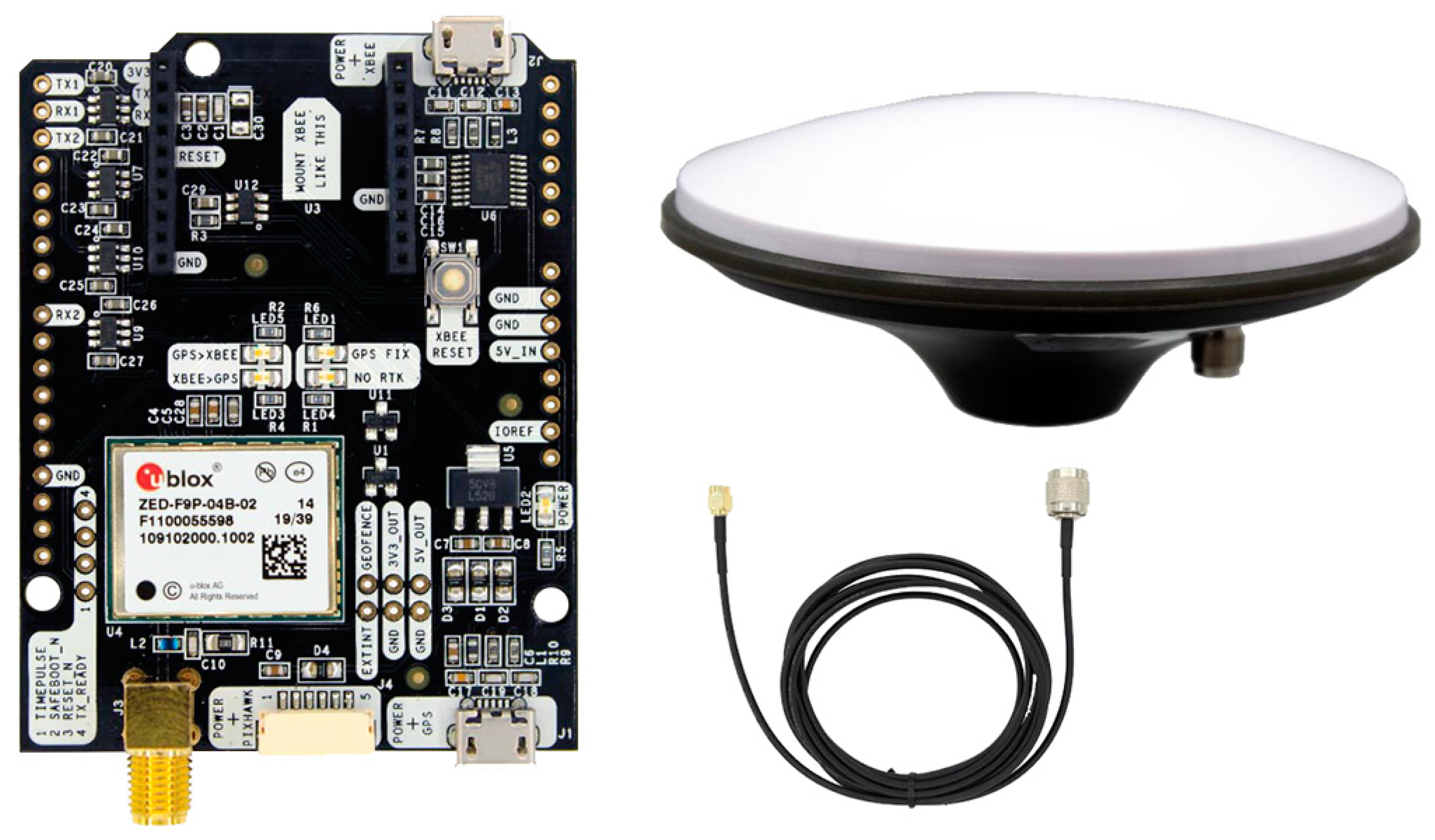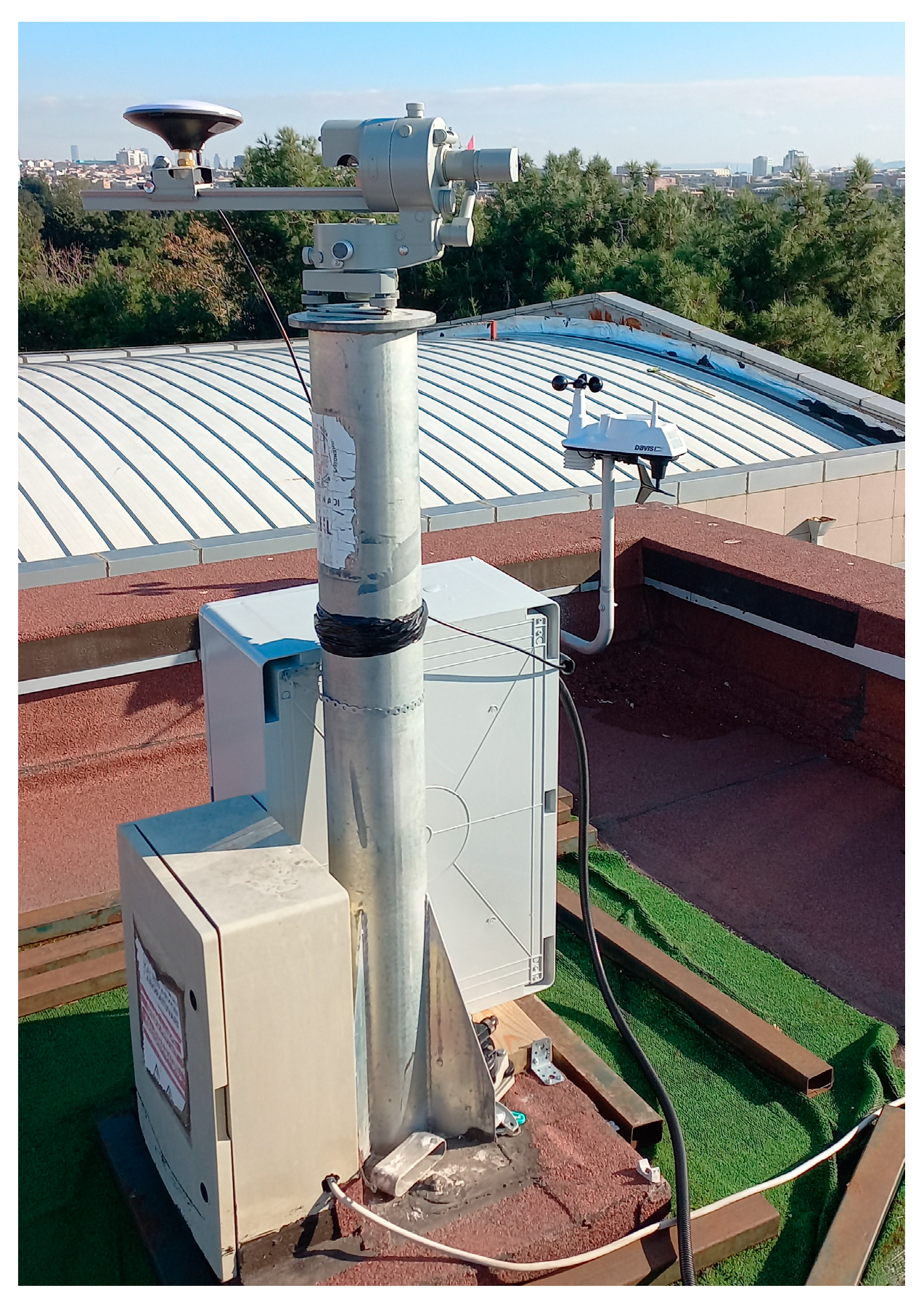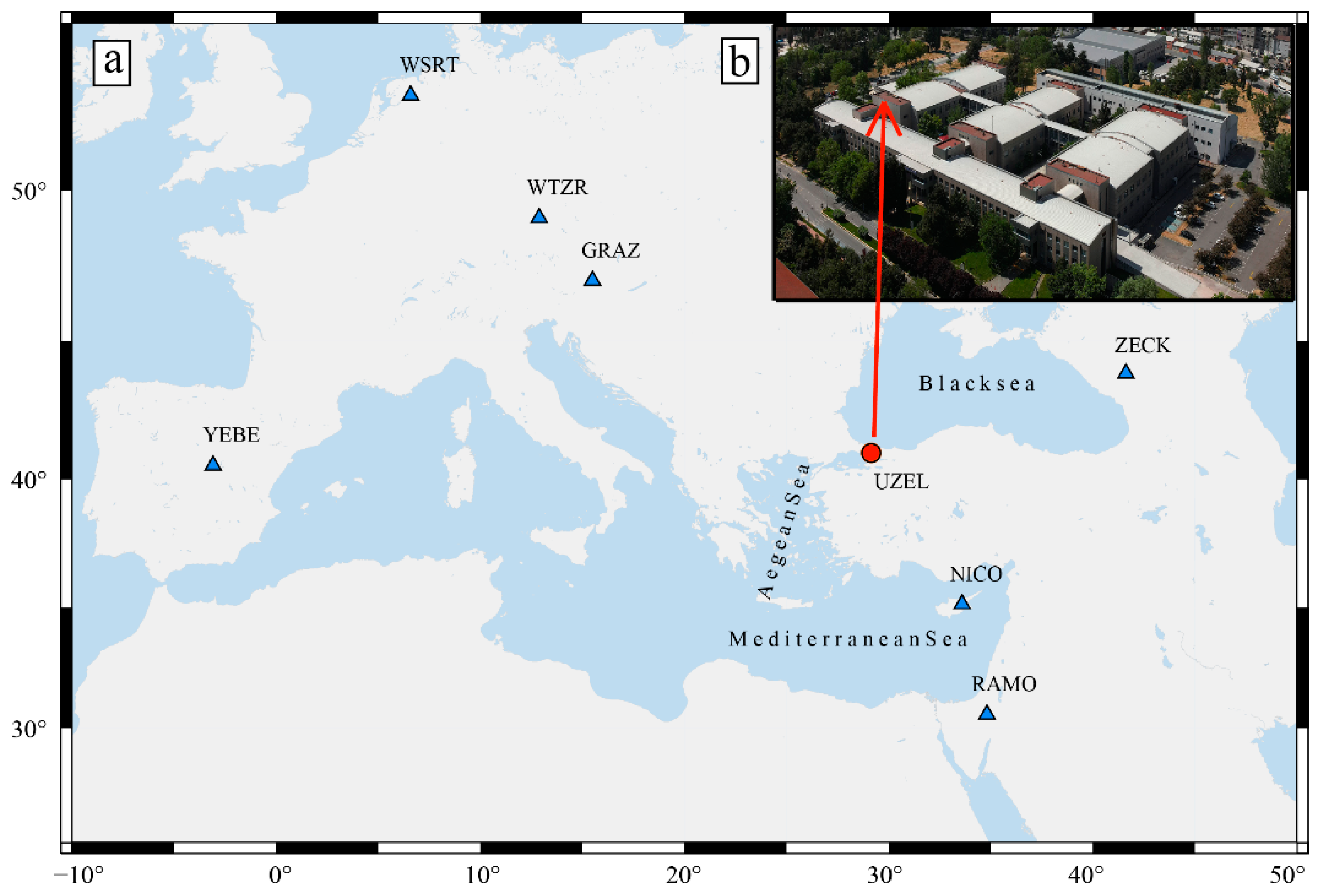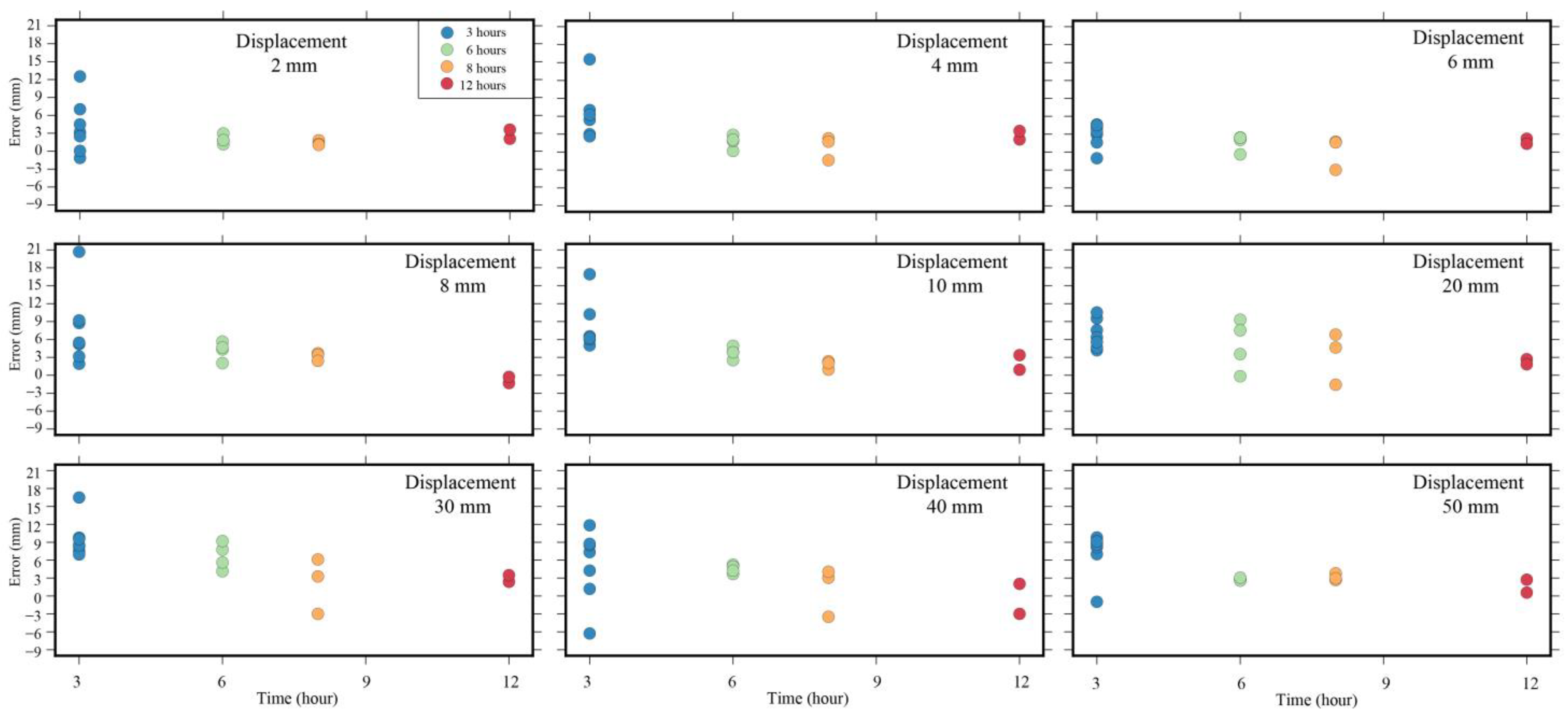Monitoring Horizontal Displacements with Low-Cost GNSS Systems Using Relative Positioning: Performance Analysis
Abstract
1. Introduction
2. Materials and Methods
3. Results and Discussion
4. Conclusions
Author Contributions
Funding
Institutional Review Board Statement
Informed Consent Statement
Data Availability Statement
Conflicts of Interest
References
- Cakir, Z.; Dogan, U.; Akoğlu, A.M.; Ergintav, S.; Özarpacı, S.; Özdemir, A.; Nozadkhalil, T.; Çakır, N.; Zabcı, C.; Erkoç, M.H.; et al. Arrest of the Mw 6.8 January 24, 2020 Elaziğ (Turkey) earthquake by shallow fault creep. Earth Planet. Sci. Lett. 2023, 608, 118085. [Google Scholar] [CrossRef]
- Özkan, A.; Solak, H.İ.; Tiryakioğlu, İ.; Şentürk, M.D.; Aktuğ, B.; Gezgin, C.; Poyraz, F.; Duman, H.; Masson, F.; Uslular, G.; et al. Characterization of the co-seismic pattern and slip distribution of the February 06, 2023, Kahramanmaraş (Turkey) earthquakes (Mw 7.7 and Mw 7.6) with a dense GNSS network. Tectonophysics 2023, 866, 230041. [Google Scholar] [CrossRef]
- Vardic, K.; Clarge, P.J.; Whitehouse, P.L. A GNSS velocity field for crustal deformation studies: The influence of glacial isostatic adjustment on plate motion models. Geophys. J. Int. 2022, 231, 426–458. [Google Scholar] [CrossRef]
- Shu, B.; He, Y.; Wang, L.; Zhang, Q.; Li, X.; Qu, X.; Huang, G.; Qu, W. Real-time high-precision landslide displacement monitoring based on a GNSS CORS network. Measurement 2023, 217, 113056. [Google Scholar] [CrossRef]
- Wang, P.; Liu, H.; Nie, G.; Yang, Z.; Wu, J.; Qian, C.; Shu, B. Performance evaluation of a real-time high-precision landslide displacement detection algorithm based on GNSS virtual reference station technology. Measurement 2022, 199, 111457. [Google Scholar] [CrossRef]
- Segina, E.; Peternel, T.; Urbancic, T.; Realini, E.; Zupan, M.; Jez, J.; Caldera, S.; Gatti, A.; Tagliaferro, G.; Consoli, A.; et al. Monitoring Surface Displacement of a Deep-Seated Landslide by a Low-Cost and near Real-Time GNSS System. Remote Sens. 2020, 12, 3375. [Google Scholar] [CrossRef]
- Bellone, T.; Dabove, P.; Manzino, A.M.; Taglioretti, C. Real-time monitoring for fast deformations using GNSS low-cost receivers, Geomatics. Nat. Hazards Risk 2016, 7, 458–470. [Google Scholar] [CrossRef]
- Hamza, V.; Stopar, B.; Sterle, O.; Pavlovcic, P. A Cost-Effective GNSS Solution for Continuous Monitoring of Landslides. Remote Sens. 2023, 15, 2287. [Google Scholar] [CrossRef]
- Xi, R.; He, Q.; Meng, X. Bridge monitoring using multi-GNSS observations with high cutoff elevations: A case study. Measurement 2021, 168, 108303. [Google Scholar] [CrossRef]
- Paziewski, J.; Stepniak, K.; Sieradzki, R.; Yigit, C.O. Dynamic displacement monitoring by integrating high-rate GNSS and accelerometer: On the possibility of downsampling GNSS data at reference stations. GPS Solut. 2023, 27, 157. [Google Scholar] [CrossRef]
- Bezcioglu, M.; Yigit, C.O.; Mazzoni, A.; Fortunato, M.; Dindar, A.A.; Karadeniz, B. High-rate (20Hz) single-frequency GPS/GALILEO variometric approach for real-time structural health monitoring and rapid risk assessment. Adv. Space Res. 2022, 70, 1388–1405. [Google Scholar] [CrossRef]
- Caldera, S.; Barindelli, S.; Sanso, F.; Pardi, L. Monitoring of Structures and Infrastructures by Low-Cost GNSS Receivers. Appl. Sci. 2022, 12, 12468. [Google Scholar] [CrossRef]
- Konca, A.O.; Karabulut, H.; Güvercin, S.E.; Eskiköy, F.; Özarpacı, S.; Özdemir, A.; Floyd, M.; Doğan, U. From Interseismic Deformation with Near-Repeating Earthquakes to Co-Seismic Rupture: A Unified View of the 2020 Mw6.8 Sivrice (Elazığ) Eastern Turkey Earthquake. J. Geophys. Res. Solid Earth 2021, 126, e2021JB021830. [Google Scholar] [CrossRef]
- Gezgin, C.; Ekercin, S.; Tiryakioğlu, İ.; Aktuğ, B.; Erdoğan, H.; Gürbüz, E.; Orhan, O.; Bilgilioğlu, S.S.; Torun, A.T.; Gündüz, H.İ.; et al. Determination of Recent Tectonic Deformations Along the Tuz Gölü Fault Zone in Central Anatolia (Turkey) with Gnss Observations. Turkish J. Earth Sci. 2022, 31, 20–33. [Google Scholar]
- Abe, D.; Yoshioka, S. Spatiotemporal distributions of interplate coupling in Tohoku, northeast Japan, for 14 years prior to the 2011 Tohoku-oki earthquake inverted from GNSS data. Tectonophysics 2022, 838, 229479. [Google Scholar] [CrossRef]
- Hung, G.; Du, S.; Wang, D. GNSS techniques for real-time monitoring of landslides: A review. Satell. Navig. 2023, 4, 5. [Google Scholar] [CrossRef]
- Aykut, N.O.; Gülal, E.; Akpınar, B. Performance of Single Base RTK GNSS Method versus Network RTK. Earth Sci. Res. J. 2015, 19, 135–139. [Google Scholar] [CrossRef]
- Yigit, C.O.; Coskun, M.Z.; Yavasoglu, H.; Arslan, A.; Kalkan, Y. The potential of GPS Precise Point Positioning method for point displacement monitoring: A case study. Measurement 2016, 91, 398–404. [Google Scholar] [CrossRef]
- Yigit, C.O.; El-Mowafy, A.; Dindar, A.A.; Bezcioglu, M.; Tiyakioglu, I. Investigating Performance of High-Rate GNSS-PPP and PPP-AR for Structural Health Monitoring: Dynamic Tests on Shake Table. J. Surv. Eng. 2020, 147, 05020011. [Google Scholar] [CrossRef]
- Topal, G.; Akpinar, B. High rate GNSS kinematic PPP method performance for monitoring the engineering structures: Shake table tests under different satellite configurations. Measurement 2022, 189, 110451. [Google Scholar] [CrossRef]
- Xi, R.; Jiang, W.; Meng, X.; Chen, H.; Chen, Q. Bridge monitoring using BDS-RTK and GPS-RTK techniques. Measurement 2018, 120, 128–139. [Google Scholar] [CrossRef]
- Zuliani, D.; Tunini, L.; Traglia, F.D.; Chersich, M.; Curone, D. Cost-Effective, Single-Frequency GPS Network as a Tool for Landslide Monitoring. Sensors 2022, 22, 3526. [Google Scholar] [CrossRef]
- Qiu, D.; Wang, L.; Luo, D.; Huang, H.; Ye, Q.; Zhang, Y. Landslide monitoring analysis of single-frequency BDS/GPS combined positioning with constraints on deformation characteristics. Surv. Rev. 2019, 51, 364–372. [Google Scholar] [CrossRef]
- Squarzoni, C.; Delacourt, C.; Allemand, P. Differential single-frequency GPS monitoring of the La Valette landslide (French Alps). Eng. Geol. 2005, 79, 215–229. [Google Scholar] [CrossRef]
- Janos, D.; Kuras, P. Evaluation of Low-Cost GNSS Receiver under Demanding Conditions in RTK Network Mode. Sensors 2021, 21, 552. [Google Scholar] [CrossRef]
- Hamza, V.; Stopar, B.; Ambrozic, T.; Turk, G.; Sterle, O. Testing Multi-Frequency Low-Cost GNSS Receivers for Geodetic Monitoring Purposes. Sensors 2020, 20, 4375. [Google Scholar] [CrossRef]
- Topal, O.G.; Karabulut, M.F.; Aykut, N.O.; Akpınar, B. Performance of low-cost GNSS equipment in monitoring of horizontal displacements. Surv. Rev. 2023, 55, 536–545. [Google Scholar] [CrossRef]
- Xue, C.; Psimoulis, P.A.; Meng, X. Feasibility analysis of the performance of low-cost GNSS receivers in monitoring dynamic motion. Measurement 2022, 202, 111819. [Google Scholar] [CrossRef]
- Carretero-Garrido, M.S.; Lacy-Perez de los Cobos, M.C.; Borque-Arancon, M.J.; Ruiz-Armenteros, A.M.; Moreno-Guerrero, R.; Gil-Cruz, A.J. Low-cost GNSS receiver in RTK positioning under the standard ISO-17123-8: A feasible option in geomatics. Measurement 2019, 137, 168–178. [Google Scholar] [CrossRef]
- Biagi, L.; Grec, C.F.; Negretti, M. Low-Cost GNSS Receivers for Local Monitoring: Experimental Simulation, and Analysis of Displacements. Sensors 2016, 16, 2140. [Google Scholar] [CrossRef]
- Hamza, V.; Stopar, B.; Sterle, O.; Pavlovcic-Preseren, P. Low-Cost Dual-Frequency GNSS Receivers and Antennas for Surveying in Urban Areas. Sensors 2023, 23, 2861. [Google Scholar] [CrossRef]
- Robustelli, U.; Cutugno, M.; Publiano, G. Low-Cost GNSS and PPP-RTK: Investigating the Capabilities of the u-blox ZED-F9P Module. Sensors 2023, 23, 6074. [Google Scholar] [CrossRef]
- Herring, T.A.; King, R.W.; McClusky, S.C. Introduction to GAMIT/GLOBK; Release 10.35; Massachussetts Institute of Technology: Cambridge, MA, USA, 2009. [Google Scholar]
- National Geodetic Survey Antenna Calibration. Available online: https://geodesy.noaa.gov/ANTCAL/ (accessed on 26 March 2024).
- Takasu, T.; Yasuda, A. Development of the low-cost RTK-GPS receiver with an open-source program package RTKLIB. In Proceedings of the International Symposium on GPS/GNSS, Jeju, Republic of Korea, 4–6 November 2009. [Google Scholar]
- Estey, L.H.; Meertens, C.M. TEQC: The multi-purpose toolkit for GPS/GLONASS data. GPS Solut. 1999, 3, 42–49. [Google Scholar] [CrossRef]






| Technical Features | U-Blox GNSS Receiver |
|---|---|
| GNSS chip | ZED-F9P |
| Constellations | GPS, GLONASS, Galileo, and BeiDou |
| Frequencies | L1/L2 |
| Signals | L1C/A, L1OF, E1, B1l, L2C, L2OF, E5b, and B2l |
| Channels | 184 |
| Weight | 19.5 g |
| Size | 69 mm 53 mm |
| Ports | 5 |
| Messages | UBX, NMEA, and RTCM3 |
| Supply voltage range | 4.5–5.5 V |
| Supply current | 80 mA |
| Technical Features | AS-ANT2BCAL Antenna |
|---|---|
| Supported positioning signal bands | GPS: L1, L2 GLONASS: G1, G2 BeiDou: B1, B2 Galileo: E1, E5b QZSS: L1, L2 SBAS: WAAS, EGNOS, MSAS, and GAGAN |
| Polarization | RHCP |
| Peak gain | 5 dBi |
| Axial Ratio @ zenith | <3 dB |
| Azimuth coverage | 360 degrees |
| Impedance | 50 ohm |
| Phase center error | ±1 mm |
| Maximum length | 152 mm |
| Weight | 400 g |
| Mounting style | Magnetic base or 5/8″ × 11TPI thread |
| Connector | TNC female |
| Period (Day) | Displacement (mm) | GPS Days | Observation Time (Hours) | Record Interval (Seconds) |
|---|---|---|---|---|
| 1 (Initial) | 0 | 076 | 24 | 30 |
| 2 | 2 | 077 | 24 | 30 |
| 3 | 4 | 078 | 24 | 30 |
| 4 | 6 | 079 | 24 | 30 |
| 5 | 8 | 080 | 24 | 30 |
| 6 | 10 | 081 | 24 | 30 |
| 7 | 20 | 082 | 24 | 30 |
| 8 | 30 | 082 | 24 | 30 |
| 9 | 40 | 084 | 24 | 30 |
| 10 | 50 | 085 | 24 | 30 |
| 3 h | 6 h | 8 h | 12 h | |
|---|---|---|---|---|
| Time interval | 00:00–03:00 03:00–06:00 06:00–09:00 09:00–12:00 12:00–15:00 15:00–18:00 18:00–21:00 21:00–24:00 | 00:00–06:00 06:00–12:00 12:00–18:00 18:00–24:00 | 00:00–08:00 08:00–16:00 16:00–24:00 | 00:00–12:00 12:00–24:00 |
| Displacement | RMSE (mm) | |||
|---|---|---|---|---|
| (mm) | 3 h | 6 h | 8 h | 12 h |
| 2 | 5.9 | 2.1 | 1.4 | 0.9 |
| 4 | 7.4 | 2.0 | 1.8 | 1.8 |
| 6 | 3.0 | 2.0 | 2.2 | 1.3 |
| 8 | 9.7 | 4.4 | 3.2 | 1.0 |
| 10 | 9.1 | 3.9 | 1.9 | 1.5 |
| 20 | 7.3 | 6.2 | 4.8 | 2.3 |
| 30 | 10.0 | 7.0 | 4.4 | 2.0 |
| 40 | 7.6 | 4.6 | 3.6 | 1.6 |
| 50 | 8.1 | 2.8 | 3.2 | 2.0 |
| 3 h | 6 h | 8 h | 12 h | |
|---|---|---|---|---|
| RMSE (mm) | 7.6 | 3.9 | 2.9 | 1.6 |
Disclaimer/Publisher’s Note: The statements, opinions and data contained in all publications are solely those of the individual author(s) and contributor(s) and not of MDPI and/or the editor(s). MDPI and/or the editor(s) disclaim responsibility for any injury to people or property resulting from any ideas, methods, instructions or products referred to in the content. |
© 2024 by the authors. Licensee MDPI, Basel, Switzerland. This article is an open access article distributed under the terms and conditions of the Creative Commons Attribution (CC BY) license (https://creativecommons.org/licenses/by/4.0/).
Share and Cite
Akpınar, B.; Özarpacı, S. Monitoring Horizontal Displacements with Low-Cost GNSS Systems Using Relative Positioning: Performance Analysis. Appl. Sci. 2024, 14, 3634. https://doi.org/10.3390/app14093634
Akpınar B, Özarpacı S. Monitoring Horizontal Displacements with Low-Cost GNSS Systems Using Relative Positioning: Performance Analysis. Applied Sciences. 2024; 14(9):3634. https://doi.org/10.3390/app14093634
Chicago/Turabian StyleAkpınar, Burak, and Seda Özarpacı. 2024. "Monitoring Horizontal Displacements with Low-Cost GNSS Systems Using Relative Positioning: Performance Analysis" Applied Sciences 14, no. 9: 3634. https://doi.org/10.3390/app14093634
APA StyleAkpınar, B., & Özarpacı, S. (2024). Monitoring Horizontal Displacements with Low-Cost GNSS Systems Using Relative Positioning: Performance Analysis. Applied Sciences, 14(9), 3634. https://doi.org/10.3390/app14093634









